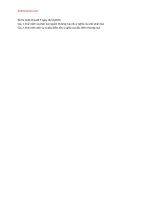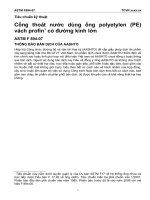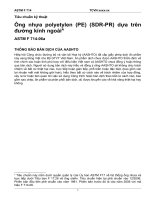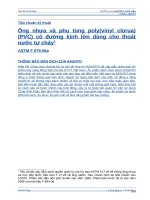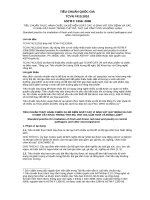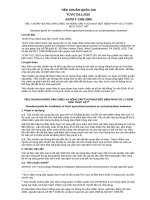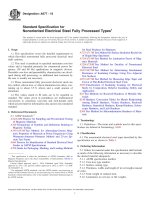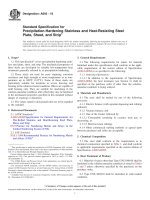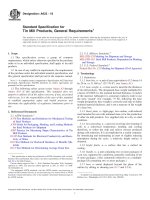Astm f 679 16
Bạn đang xem bản rút gọn của tài liệu. Xem và tải ngay bản đầy đủ của tài liệu tại đây (138.83 KB, 8 trang )
Designation: F679 − 16
Standard Specification for
Poly(Vinyl Chloride) (PVC) Large-Diameter Plastic Gravity
Sewer Pipe and Fittings1
This standard is issued under the fixed designation F679; the number immediately following the designation indicates the year of original
adoption or, in the case of revision, the year of last revision. A number in parentheses indicates the year of last reapproval. A superscript
epsilon (´) indicates an editorial change since the last revision or reapproval.
D1784 Specification for Rigid Poly(Vinyl Chloride) (PVC)
Compounds and Chlorinated Poly(Vinyl Chloride)
(CPVC) Compounds
D2122 Test Method for Determining Dimensions of Thermoplastic Pipe and Fittings
D2152 Test Method for Adequacy of Fusion of Extruded
Poly(Vinyl Chloride) (PVC) Pipe and Molded Fittings by
Acetone Immersion
D2321 Practice for Underground Installation of Thermoplastic Pipe for Sewers and Other Gravity-Flow Applications
D2412 Test Method for Determination of External Loading
Characteristics of Plastic Pipe by Parallel-Plate Loading
D2444 Test Method for Determination of the Impact Resistance of Thermoplastic Pipe and Fittings by Means of a
Tup (Falling Weight)
D2564 Specification for Solvent Cements for Poly(Vinyl
Chloride) (PVC) Plastic Piping Systems
D2855 Practice for the Two-Step (Primer and Solvent Cement) Method of Joining Poly (Vinyl Chloride) (PVC) or
Chlorinated Poly (Vinyl Chloride) (CPVC) Pipe and
Piping Components with Tapered Sockets
D3212 Specification for Joints for Drain and Sewer Plastic
Pipes Using Flexible Elastomeric Seals
F402 Practice for Safe Handling of Solvent Cements,
Primers, and Cleaners Used for Joining Thermoplastic
Pipe and Fittings
F412 Terminology Relating to Plastic Piping Systems
F477 Specification for Elastomeric Seals (Gaskets) for Joining Plastic Pipe
2.2 Federal Standard:
Fed. Std. No. 123 Marking for Shipment (Civil Agencies)3
2.3 Military Standard:
MIL-STD-129 Marking for Shipment and Storage3
1. Scope*
1.1 This specification covers requirements and test methods
for materials, dimensions, workmanship, flattening resistance,
impact resistance, pipe stiffness, extrusion quality, joining
system, and a form of marking for large diameters, 18 to 60 in.
poly(vinyl chloride) (PVC) sewer pipe and fittings with integral bell elastomeric seal joints or solvent cemented sockets.
1.2 The requirements of this specification are intended to
provide pipe and fittings suitable for nonpressure drainage of
sewage and surface water. Pipe and fittings produced to this
specification should be installed in accordance with Practice
D2321.
NOTE 1—Industrial waste disposal lines should be installed only with
the specific approval of the governing code authority since temperatures in
excess of 140°F (60°C) and chemicals not commonly found in drains and
sewers may be encountered.
1.3 The values stated in inch-pound units are to be regarded
as standard. The values given in parentheses are mathematical
conversions to SI units that are provided for information only
and are not considered standard.
1.4 The following precautionary caveat pertains only to the
test method portion, Section 8, of this specification: This
standard does not purport to address all of the safety problems,
if any, associated with its use. It is the responsibility of the user
of this standard to establish appropriate safety and health
practices and determine the applicability or regulatory limitations prior to use.
2. Referenced Documents
2.1 ASTM Standards:2
D618 Practice for Conditioning Plastics for Testing
D1600 Terminology for Abbreviated Terms Relating to Plastics
3. Terminology
3.1 Definitions:
3.1.1 General—Definitions used in the specification are in
accordance with Terminology F412, unless otherwise indicated. The abbreviation for poly(vinyl chloride) pipe is PVC, in
accordance with Terminology D1600.
1
This specification is under the jurisdiction of ASTM Committee F17 on Plastic
Piping Systems and is the direct responsibility of Subcommittee F17.62 on Sewer.
Current edition approved Aug. 1, 2016. Published November 2016. Originally
approved in 1980. Last previous edition approved in 2015 as F679 – 15. DOI:
10.1520/F0679-16.
2
For referenced ASTM standards, visit the ASTM website, www.astm.org, or
contact ASTM Customer Service at For Annual Book of ASTM
Standards volume information, refer to the standard’s Document Summary page on
the ASTM website.
3
Available from DLA Document Services, Building 4/D, 700 Robbins Ave.,
Philadelphia, PA 19111-5094, .
*A Summary of Changes section appears at the end of this standard
Copyright © ASTM International, 100 Barr Harbor Drive, PO Box C700, West Conshohocken, PA 19428-2959. United States
1
F679 − 16
TABLE 1 Pipe Dimensions and Minimum Pipe Stiffness
Nominal Pipe
Size
in.
30
36
42
48
54
60
30
36
42
48
54
60
30
36
42
48
54
60
18
21
24
27
CIOD
CIOD
CIOD
CIOD
CIOD
CIOD
18
21
24
27
CIOD
CIOD
CIOD
CIOD
CIOD
CIOD
18
21
24
27
CIOD
CIOD
CIOD
CIOD
CIOD
CIOD
Average Outside
Diameter
Tolerance on Average
Outside Diameter
Min Wall Thickness
Min Pipe Stiffness
in.
(mm)
in.
(mm)
in.
(mm)
psi
kPa
18.701
22.047
24.803
27.953
32.000
38.300
44.500
50.800
57.560
61.610
18.701
22.047
24.803
27.953
32.000
38.300
44.500
50.800
57.560
61.610
18.701
22.047
24.803
27.953
32.000
38.300
44.500
50.800
57.560
61.610
(475)
(560)
(630)
(710)
(813)
(973)
(1130)
(1290)
(1462)
(1565)
(475)
(560)
(630)
(710)
(813)
(973)
(1130)
(1290)
(1462)
(1565)
(475)
(560)
(630)
(710)
(813)
(973)
(1130)
(1290)
(1462)
(1565)
±0.028
±0.033
±0.037
±0.042
±0.040
±0.050
±0.060
±0.075
±0.085
±0.090
±0.028
±0.033
±0.037
±0.042
±0.040
±0.050
±0.060
±0.075
±0.085
±0.090
±0.028
±0.033
±0.037
±0.042
±0.040
±0.050
±0.060
±0.075
±0.085
±0.090
(±0.71)
(±0.84)
(±0.94)
(±1.07)
(±1.02)
(±1.27)
(±1.52)
(±1.90)
(±2.15)
(±2.30)
(±0.71)
(±0.84)
(±0.94)
(±1.07)
(±1.02)
(±1.27)
(±1.52)
(±1.90)
(±2.15)
(±2.30)
(±0.71)
(±0.84)
(±0.94)
(±1.07)
(±1.02)
(±1.27)
(±1.52)
(±1.90)
(±2.15)
(±2.30)
0.499
0.588
0.661
0.745
0.853
1.021
1.187
1.355
1.535
1.643
0.584
0.689
0.775
0.874
1.000
1.197
1.391
1.588
1.799
1.926
0.671
0.791
0.889
1.002
1.148
1.373
1.596
1.822
2.064
2.210
(12.7)
(14.9)
(15.5)
(18.9)
(21.7)
(25.9)
(30.1)
(34.4)
(39.0)
(41.7)
(14.8)
(17.5)
(19.7)
(22.2)
(25.4)
(30.4)
(35.3)
(40.3)
(45.7)
(48.9)
(17.0)
(20.1)
(22.6)
(25.5)
(29.1)
(34.1)
(40.5)
(46.3)
(52.4)
(56.1)
46
46
46
46
46
46
46
46
46
46
75
75
75
75
75
75
75
75
75
75
115
115
115
115
115
115
115
115
115
115
(320)
(320)
(320)
(320)
(320)
(320)
(320)
(320)
(320)
(320)
(517)
(517)
(517)
(517)
(517)
(517)
(517)
(517)
(517)
(517)
(790)
(790)
(790)
(790)
(790)
(790)
(790)
(790)
(790)
(790)
5.1.2 The assembly of joints shall be in accordance with the
pipe manufacturer’s recommendations.
5.2 Solvent cement joints for pipe and fittings—In the
solvent cement joint, the pipe spigot wedges into the tapered
socket and the surfaces fuse together. The tapered socket may
be a portion of a molded fitting or it may be a belled end of the
pipe section. Formed bells shall be concentric with pipe axis.
5.2.1 The assembly of the joints shall be accordance with
Practice D2855.
5.2.2 Joint Tightness—Joints made with pipe and fittings or
with belled-end pipe shall show no signs of leakage when
tested in accordance with 7.5.
4. Materials
4.1 Basic Materials—The pipe shall be made of PVC plastic
having a minimum cell classification of 12364 or 12454 as
defined in Specification D1784. Homopolymer PVC compounds must equal or exceed the requirements of the above
listed minimum cell classification number.
4.2 Rework Material—Clean rework material generated
from the manufacturer’s own pipe or fittings production may
be used by the same manufacturer provided that the rework
material meets the requirements of 4.1 and that the pipe or
fittings produced meet all the requirements of this specification.
6. Requirements
6.1 Workmanship—The pipe and fittings shall be homogeneous throughout and free from visible cracks, holes, foreign
inclusions, or other injurious defects. The pipe shall be as
uniform as commercially practical in color, opacity, density,
and other physical properties.
6.2 Pipe Dimensions:
6.2.1 Pipe Diameter—The average outside diameter of the
pipe shall meet the requirements given in Table 1, when
measured in accordance with Test Method D2122.
6.2.2 Wall Thickness—Pipe wall thicknesses shall meet the
requirements of Table 1, when measured in accordance with
Test Method D2122. In the case of belled pipe and fittings
fabricated from pipe sections, the thickness of the wall in the
bell shall be considered satisfactory if it was formed from pipe
meeting the above requirements.
4.3 Gaskets—Rubber gaskets shall be in compliance with
Specification F477.
4.4 Lubricant—The lubricant used for assembly shall have
no detrimental effect on the gasket or pipe.
4.5 Primer.
4.6 Solvent Cement.
5. Joining System
5.1 Integral Bell Gasketed Joint—The joint shall be designed so that when assembled, the gasket inside the bell will
be compressed radially on the pipe spigot to form a water-tight
seal.
5.1.1 The joint shall be designed to avoid displacement of
the gasket when installed in accordance with the manufacturer’s recommendations.
2
F679 − 16
7.2 Socket Depth—The socket depth shall not be less than
that shown in Table 2.
NOTE 2—The wall thickness varaibility in any cross section of the pipe
is normally 12% or less.
6.3 Pipe Flattening—There shall be no evidence of
splitting, cracking, or breaking, when pipe is tested in accordance with 8.4.
7.3 Spigot Length—The minimum distance from the spigot
end to the area where the spigot diameter changes due to a
socket, branch, or change in angle shall comply with the “C”
dimension of Table 2.
6.4 Wall Thickness of Fittings—The minimum wall thicknesses of the fittings shall be the same as the minimum wall
thickness of the equivalent size of pipe as specified in Table 1.
For reducing fittings or those with smaller inlets, the minimum
wall thickness of each inlet shall be no less than the minimum
wall thickness for that size pipe. The thickness shall be
determined in accordance with Test Method D2122.
7.4 Solvent Cement—The solvent cement manufacturer’s
recommendations should be followed in selecting the proper
cement viscosity for joining the large diameter pipe.
7.5 Joint Tightness—Join two pieces of pipe by means of a
fitting or socket in accordance with Practice D2855 and using
solvent cement as described in 7.4. Allow the joined unit to
stand 24 h at room temperature. Joints made with pipe and
fittings shall show no sign of leakage when subjected to an
internal water pressure of 170 kPa (25 psi) at room temperature
for 1 h.
NOTE 3—Owing to the present state of technology in the industry, all
fittings are fabricated fittings. Fabricated fittings with solvent-cemented
components should be made in accordance with Practice D2855 and
taking cognizance of Practice F402.
6.5 Pipe Impact Strength—The impact strength of the pipe
shall be not less than 220 ft·lbf (298.3 J), when tested in
accordance with 8.5.
8. Test Methods
8.1 Conditioning:
8.1.1 Referee Testing—When conditioning is required for
referee tests, condition the specimens in accordance with
Procedure A of Practice D618 at 73.4 6 3.6°F (23 6 2°C) and
50 6 5 % relative humidity for not less than 40 h prior to test.
Conduct tests under the same conditions of temperature and
humidity, unless otherwise specified.
8.1.2 Quality Control Tests—For quality control tests, condition specimens for a minimum of 4 h in air or 1 h in water at
73.4 6 3.6°F (23 6 2°C). Test the specimens at 236 2°C
without regard to relative humidity.
NOTE 4—This requirement is intended only for use as a quality control
test, not as a simulated service test. As aged impact data is developed, the
applicable aged impact values will be included to reflect long-term
performance needs.
6.6 Pipe Stiffness—Pipe stiffness values for the pipe shall
comply with Table 1, when tested in accordance with 8.6.
6.6.1 The wall thickness must be increased to meet the pipe
stiffness requirement PS46 or PS115 listed in Table 1 when
material with modulus lower than 500,000 psi (3447 MPa) is
used.
6.7 Gaskets:
6.7.1 All gaskets shall meet the requirements of Specification F477 and be molded into a circular form or extruded to the
proper section and then spliced into circular form. Gaskets
shall be made of a properly vulcanized high-grade elastomeric
compound.
6.7.2 The basic polymer shall be natural rubber, synthetic
elastomer, or a blend of both.
6.7.3 The gasket shall be designed with an adequate compressive force so as to effect a positive seal under all combinations of joint tolerances. The gasket shall be the only element
depended upon to make the joint flexible and watertight.
8.2 Test Conditions—Conduct tests in the Standard Laboratory Atmosphere of 73.4 6 3.6°F (23 6 2°C) and 50 6 5 %
relative humidity, unless otherwise specified in this specification. In cases of disagreement, the tolerances shall be 61.8°F
(61°C) and 62 % relative humidity.
8.3 Sampling—The selection of the sample or samples of
pipe shall be as agreed upon between the purchaser and seller.
In case of no prior agreement, any sample selected by the
testing laboratory shall be deemed adequate.
8.4 Flattening—Flatten three specimens of pipe, each 6 in.
(152 mm) in length, between parallel plates in a suitable press
until the distance between the plates is 40 % of the outside
diameter of the pipe. The rate of loading shall be uniform and
such that the compression is completed within 2 to 5 min. The
specimen shall pass if no splitting, cracking, or breaking is
observed under normal light with the unaided eye.
6.8 Joint Tightness—Joints made with pipe and fittings shall
show no sign of leakage, when tested in accordance with
Specification D3212. All surfaces of the joint upon which the
gasket may bear shall be smooth and free of imperfections,
ridges, fractures, or cracks that could adversely affect sealability.
7. Requirements for Solvent Cemented Pipes and Fittings
8.5 Impact Resistance—Determine the impact resistance of
the pipe in accordance with Test Method D2444, using a 30-lb
(15-kg) or 20-lb (10-kg) Tup B and flat-plate holder B. Test six
specimens. All shall pass. If one fails, test another six specimens; 11 passes out of 12 tested shall be acceptable. If two or
more specimens fail, results shall be considered unacceptable
and the test shall be recorded as a failure with no further
retesting allowed.
7.1 Socket diameter—The inside diameter of the tapered
socket shall comply with dimensions listed in Table 2.
NOTE 6—Sections shorter than those specified in Test Method D2444,
but not less than 6 in. (152 mm) in length, may be tested to accommodate
6.9 Acetone Immersion—The pipe shall not show excessive
flaking or disintegrate, when tested in accordance with Test
Method D2152.
NOTE 5—This test is intended only for use as a quality control test and
not for use as a simulated service test.
3
F679 − 16
TABLE 2 Solvent Cement Socket Dimensions
Solvent Cement Socket Dimensions
Nominal Size, in.
18
21
24
27
30
36
42
48
54
60
18.757
22.113
24.877
28.037
32.080
38.400
44.620
50.950
57.730
61.790
A
±
±
±
±
±
±
±
±
±
±
0.028
0.033
0.037
0.042
0.040
0.050
0.060
0.075
0.085
0.090
18.673
22.014
24.766
27.911
31.960
38.250
44.440
50.725
57.475
61.520
B
±
±
±
±
±
±
±
±
±
±
0.028
0.033
0.037
0.042
0.040
0.050
0.060
0.075
0.085
0.090
C
9.000
10.500
12.000
13.500
15.000
18.000
21.000
24.000
27.000
30.000
seller. There shall be no agreement to lower the minimum
requirement of the specification by such means as omitting
tests that are a part of the specification, substituting or
modifying a test method, or by changing the specification
limits. In retesting, the product requirements of this specification shall be met, and the test methods designated in the
specification shall be followed. If, upon retest, failure occurs,
the quantity of product represented by the test(s) does not meet
the requirements of this specification.
the impact-testing machine since this will be a more severe impactresistance test.
8.6 Pipe Stiffness—Determine the pipe stiffness at 5 %
deflection datum in accordance with Test Method D2412. Test
three specimens, each 6 in. (152 mm) in length, and determine
the average pipe stiffness at 5 % deflection in accordance with
Test Method D2412. The pipe stiffness shall equal or exceed
the minimum value listed in Table 1.
NOTE 7—The 5 % deflection criterion, which was arbitrarily selected
for testing convenience, should not be considered as a limitation with
respect to in-use deflection. The engineer is responsible for establishing
the acceptable deflection limit.
10. Inspection
10.1 General—Inspection by the purchaser shall not relieve
the manufacturer of the responsibility of furnishing material
meeting in all respects the requirements of this specification.
8.7 Acetone Immersion—This test shall be conducted in
accordance with Test Method D2152. This procedure is used
for determining the degree of fusion of extruded PVC plastic
pipe as indicated by reaction to immersion in anhydrous
acetone. It is applicable only for distinguishing between
unfused and properly fused PVC.
9. Retest and Rejection
10.2 Notification—If inspection is specified by the
purchaser, the manufacturer shall notify the purchaser in
advance of the date, time, and place of testing of the pipe in
order that the purchaser may be represented at the test.
9.1 If the results of any test(s) do not meet the requirements
of this specification, the test(s) may be conducted again in
accordance with an agreement between the purchaser and the
10.3 Access—The inspector shall have free access to those
parts of the manufacturer’s plant that are involved in work
performed under this specification. The manufacturer shall
4
F679 − 16
12.1.5 This designation: ASTM F679.
12.1.6 Gasketed pipe shall have an insertion depth mark on
the spigot end.
afford the inspector all reasonable facilities for determining
whether the pipe meets the requirements of this standard.
11. Certification
12.2 Fittings Marking—Fittings in compliance with this
standard shall be clearly marked with the following information:
12.2.1 Manufacturer’s name or trademark and code,
12.2.2 Nominal size,
12.2.3 Material designation: “PVC”, and
12.2.4 This designation: “ASTM F679”.
11.1 When specified in the purchase order or contract, a
manufacturer’s certification shall be furnished to the purchaser
that the material was manufactured, sampled, tested, and
inspected in accordance with this specification, and has been
found to meet the requirements. When specified in the purchase order or contract, a report of the test results shall be
furnished. Each certification so furnished shall be signed by an
authorized agent of the manufacturer.
NOTE 8—Manufacturer’s code to include year, month, day, shift, plant,
and extruder of manufacture.
12. Marking
13. Delivery
12.1 Pipe Marking—Each standard and random length of
pipe in compliance with this specification shall be clearly
marked with the following information at intervals of 5 ft. (1.5
m) or less:
12.1.1 Manufacturer’s name or trademark and code,
12.1.2 Nominal pipe size,
12.1.3 PVC minimum cell classification (as listed in Table
1),
12.1.4 Pipe stiffness designation: “PS 46 PVC Sewer Pipe”,
PS 75 PVC Sewer Pipe” or “PS 115 PVC Sewer Pipe,” and
13.1 All pipe and couplings and fittings shall be packaged
for standard commercial shipment, unless otherwise specified.
14. Quality Assurance
14.1 When the product is marked with this designation,
F679, the manufacturer affirms that the product was
manufactured, inspected, sampled, and tested in accordance
with this specification and has been found to meet the
requirements of this specification.
SUPPLEMENTARY REQUIREMENTS
GOVERNMENT / MILITARY PROCUREMENT
These requirements apply only to Federal/Military procurement, not domestic sales or transfers.
S2.1 Packaging—Unless otherwise specified in the
contract, the materials shall be packaged in accordance with
the supplier’s standard practice in a manner ensuring arrival at
destination in satisfactory condition and which will be acceptable to the carrier at lowest rates. Containers and packing shall
comply with Uniform Freight Classification rules or National
Motor Freight Classification rules.
S2.2 Marking—Marking for shipment shall be in accordance with Fed. Std. No. 123 for civil agencies and MIL-STD129 for military agencies.
S1. Responsibility for Inspection—Unless otherwise specified in the contract or purchase order, the producer is responsible for the performance of all inspection and test requirements specified herein. The producer may use his own or any
other suitable facilities for the performance of the inspection
and test requirements specified herein, unless the purchaser
disapproves. The purchaser shall have the right to perform any
of the inspections and tests set forth in this specification where
such inspections are deemed necessary to ensure that material
conforms to prescribed requirements.
NOTE S1.1—In Federal contracts, the contractor is responsible for
inspection.
NOTE S2.1—The inclusion of U. S. Government procurement requirements should not be construed as an indication that the U. S. Government
uses or endorses the products described in this document.
S2. Packaging and Marking for U. S. Government Procurement:
5
F679 − 16
APPENDIXES
(Nonmandatory Information)
X1. APPLICABLE DOCUMENT
X1.1 The following ASTM standard applies to this specification:
D2564 Specification for Solvent Cements for Poly(Vinyl
Chloride) (PVC) Plastic Pipe and Fittings
X2. BASE INSIDE DIAMETER FOR CALCULATION OF DEFLECTION LIMIT
X2.1 Table X2.1 is provided to establish a uniform number
representing the inside diameter to be used as a base for
calculation of deflection limits. For the purpose of monitoring
the quality of installation, a specifier may apply a deflection
limit that he deems appropriate to the base inside diameter to
arrive at a mandrel dimension for a go/no-go gage. For
economy in fabrication of mandrels, it is suggested that the
outside diameter of each mandrel be rounded to the nearest
0.01 in. or 0.2 mm for machining purposes. This procedure is
demonstrated here for the 71⁄2 % recommended limit of Appendix X3 (Example: (100 − 7.5 %) ⁄100× 5.800 = 5.37).
X2.2 This base inside diameter is not a product quality
control requirement, nor should it be used for flow calculations.
6
F679 − 16
X3. RECOMMENDED LIMIT FOR INSTALLED DEFLECTION
TABLE X2.1 Base Inside Diameters and 71⁄2 % Deflection Mandrel DimensionsA
PS 46
Nominal Size,
in.
30
36
42
48
54
60
18
21
24
27
CIOD
CIOD
CIOD
CIOD
CIOD
CIOD
Average Inside
Diameter, in. (mm)
Base Inside Diameter,
in. (mm)
71⁄2 % Deflection
Mandrel
17.643 (448.13)
20.800 (528.32)
23.402 (594.41)
26.374 (669.90)
30.192 (766.88)
36.135 (917.83)
41.984 (1066.39)
47.927 (1217.35)
54.306 (1379.37)
58.127 (1476.43)
17.054 (433.17)
20.098 (510.49)
22.586 (573.68)
25.446 (646.33)
29.151 (740.44)
34.869 (885.67)
40.491 (1028.47)
46.209 (1173.71)
52.359 (1329.93)
55.961 (1421.41)
15.77
18.59
20.89
23.53
26.96
32.25
37.45
42.74
48.43
51.76
Average inside
Diameter, in.
(mm)
17.278 (438.86)
20.370 (517.40)
22.918 (582.12)
25.829 (656.06)
29.566 (750.97)
35.389 (898.88)
41.116 (1044.35)
46.937 (1192.20)
53.184 (1350.87)
56.926 (1445.92)
PS 115
Base Inside
Diameter in.
(mm)
16.688 (423.87)
19.666 (499.52)
22.102 (561.39)
24.899 (632.43)
28.523 (724.48)
34.120 (866.65)
39.621 (1006.37)
45.216 (1148.49)
51.234 (1301.34)
54.756 (1390.81)
71⁄2 % Deflection
Mandrel
15.44
18.19
20.44
23.03
26.38
31.56
36.65
41.82
47.39
50.65
A
Base inside diameter is a minimum pipe inside diameter derived by subtracting a statistical tolerance package from the pipe’s average inside diameter. The tolerance
package is defined as the square root of the sum of squared standard manufacturing tolerances.
Average inside diameter = average outside diameter − 2(1.06)t
Tolerance package 5 œ A 2 12B 2 1C 2
where:
t
=
A
=
B
=
C
=
minimum wall thickness,
outside diameter tolerance,
excess wall thickness tolerance = 0.06t, and
out-of-roundness tolerance.
For sizes 18 through 27 the values for C were derived statistically from field measurement data and are
given as follows for various sizes of pipe For sizes larger than 27, the value for C were extrapolated from the
field data for the smaller sizes.
Nominal Size, in.
18
21
24
27
30 CIOD
36 CIOD
42 CIOD
48 CIOD
Value for C, in. (mm)
0.587 (14.91)
0.700 (17.78)
0.812 (20.62)
0.925 (23.50)
1.038 (26.37)
1.263 (32.08)
1.488 (37.80)
1.713 (43.51)
perform satisfactorily provided that the internal diameter of the
barrel is not reduced by more than 71⁄2 % of its base inside
diameter when measured not less than 30 days following
completion of installation.
X3.1 Design engineers, public agencies, and others who
have the responsibility to establish specifications for maximum
allowable limits for deflection of installed PVC sewer pipe
have requested direction relative to such a limit.
X3.2 PVC sewer piping made to this specification andinstalled in accordance with Practice D2321 can be expected to
7
F679 − 16
SUMMARY OF CHANGES
Committee F17 has identified the location of selected changes to this standard since the last issue (F679 – 15)
that may impact the use of this standard. (Approved August 1, 2015.)
(4) Added Table 2.
(5) Added 7.1 – 7.3.
(1) Section 1.1 - Added “Solvent cemented sockets”
(2) Added 4.5 and 4.6.
(3) Section 5 was revised.
ASTM International takes no position respecting the validity of any patent rights asserted in connection with any item mentioned
in this standard. Users of this standard are expressly advised that determination of the validity of any such patent rights, and the risk
of infringement of such rights, are entirely their own responsibility.
This standard is subject to revision at any time by the responsible technical committee and must be reviewed every five years and
if not revised, either reapproved or withdrawn. Your comments are invited either for revision of this standard or for additional standards
and should be addressed to ASTM International Headquarters. Your comments will receive careful consideration at a meeting of the
responsible technical committee, which you may attend. If you feel that your comments have not received a fair hearing you should
make your views known to the ASTM Committee on Standards, at the address shown below.
This standard is copyrighted by ASTM International, 100 Barr Harbor Drive, PO Box C700, West Conshohocken, PA 19428-2959,
United States. Individual reprints (single or multiple copies) of this standard may be obtained by contacting ASTM at the above
address or at 610-832-9585 (phone), 610-832-9555 (fax), or (e-mail); or through the ASTM website
(www.astm.org). Permission rights to photocopy the standard may also be secured from the Copyright Clearance Center, 222
Rosewood Drive, Danvers, MA 01923, Tel: (978) 646-2600; />
8
